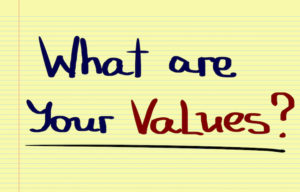
”Do you teach values?” a telephone caller asked.
Back in the early 90’s parents were upset that values were being taught in school. Controversy brewed and bubbled.
Do you teach values? The question caught me off guard. How can you not teach values, I thought, because of the very nature of values? Whether we are aware of it or not, we assign value to everything in our lives.
What we prize the most, what we give the most time to or put the most money towards–those decisions create our values.
Values, according to the American Heritage Dictionary, are ”principles, standards or qualities considered worthwhile or desirable.” As a verb, value can mean ”to rate according to a relative estimate of worth or desirability.”
It seems a logical conclusion that we have values because we rate some qualities higher than other qualities. We cannot not possess values.
Being aware of what we value highly can help us make informed decisions, be it a complicated moral decision or as simple as choosing what kind of ice cream we’ll pick out of the freezer.
Many people see values tied to religion and are concerned that teaching values in our schools is the same as teaching religion.
At one time or another, consciously or unconsciously, most of us take the time to consider what is most precious to us and what items we can do without. In this thinking process we can assign value or importance to ideas, relationships or every item in our lives.
When we can articulate what we value the most, we empower ourselves to be more effective in our lives and relationships with others.
In Teaching Your Children Values Linda and Richard Eyre have a 12-month plan to introduce a principle every month. Each principle includes teaching methods to use with your preschooler, elementary-aged child or adolescent. The Eyres recommend discussing a specific value for each month of the year, then starting the process over again, as different circumstances will fuel the learning and discussion process each year.
The Eyres divide these 12 principles into two major categories: The Values of Being and the Values of Giving.
The Values of Being begin with the development of an internal quality or attitude that determines how we behave and interact with others. These principles include honesty, courage, peacefulness, self-reliance and potential, discipline and moderation, and fidelity and chastity.
The Values of Giving are qualities we offer to others and determine our character. Loyalty and dependability, respect, love, unselfishness and sensitivity, kindness and friendliness, and justice and mercy belong to this group of values.
The principles and teaching tools the Eyres recommend can act as a starting point in helping guide your children to understanding what they value in life. Perhaps working with your children on values will clarify your own beliefs.


Maren, I like this article, but need more guidance/ideas on how to help my 3 year old understand the value of being. I think in our family we teach this everyday just by being but she does seem to get it. Thank you.
Gloria,
In the Eyre’s book, Teaching Your Children Values, they outline a 12 month curriculum for three age groups–preschooler, elementary and adolescent.
I’ve found their suggestions to be age appropriate.
But it is with our modeling these values of being and giving that our children learn the most.
When we are able to articulate our values and offer practical lessons to illuminate these ideas, we create clarity around concepts and help with understanding.
A three-year-old is absorbing information from the world around her. It is during the elementary years that “why” we act and think a certain way becomes a topic for discussion. Elementary age children want to know why we do things the way we do. Preschoolers work to learn how to treat other people, by watching us.
You might enjoy Evie’s comments, too.
Thank you for the article, Maren. It’s interesting to read about values being organized and taught in this way, as if they were academic subjects. I never thought about it this way.
In my 6-9 class I teach values daily, directly or indirectly, I guess, the way values have traditionally been taught in my family. I didn’t preach, I was bringing the value into the experience of my daughter, just naturally and when an incident happened, I would bring it to her experience directly, so that she could link the value and the name of the value with the incident.
By repetition and consistency she understood and later she started practicing the same. In takes time. In my 6-9 class, I always keep at the back of my mind the second plane of development characteristics (mainly fairness and morals, in this context) so I make sure fairness and moral/ social values that make us who we are as human beings are brought into the picture, appealing to the child’s reasoning mind.
My personal values (for example, respect for the other, loving kindness) are present through who I am and how I react to things in the environment. Then, when an incident happens, however small, I address it, I am afraid, at the expense of teaching time, but I consider it very important. I discuss it either privately with the children who are involved, or in the group, if I feel that everybody can benefit.
What is built in the classroom supplements what is taught at home.
Again, your personal values matter, because they are reflected in what you do, not so much in what you say. In time, by systematically practicing this, the children internalize the ideas and this transforms who they are as individuals and as members of the group. It creates bonding and a sense of community, even if conflicts are still there, they have a different quality in them.
I see it in every class, and with every group. It is the most precious of my teaching experiences.
For a 3 year old, because the reasoning mind is not yet developed, I would keep it simple, in a matter-of-fact way. Not too many words, not so much explanation. Simple ideas, simply delivered. Thank you for opportunity to share these thoughts. I hope they help.
Evie,
Thanks for sharing your experiences.
I believe the time we spend helping elementary students understand “why” is time well-spent.
Teaching your children moral values will help them know the right and wrong. It will help them set lifetime behavioral ethics.
Check this out Important Morals You Should Teach Children
Hope this will help. Thank you.
Regards,
Caroleann